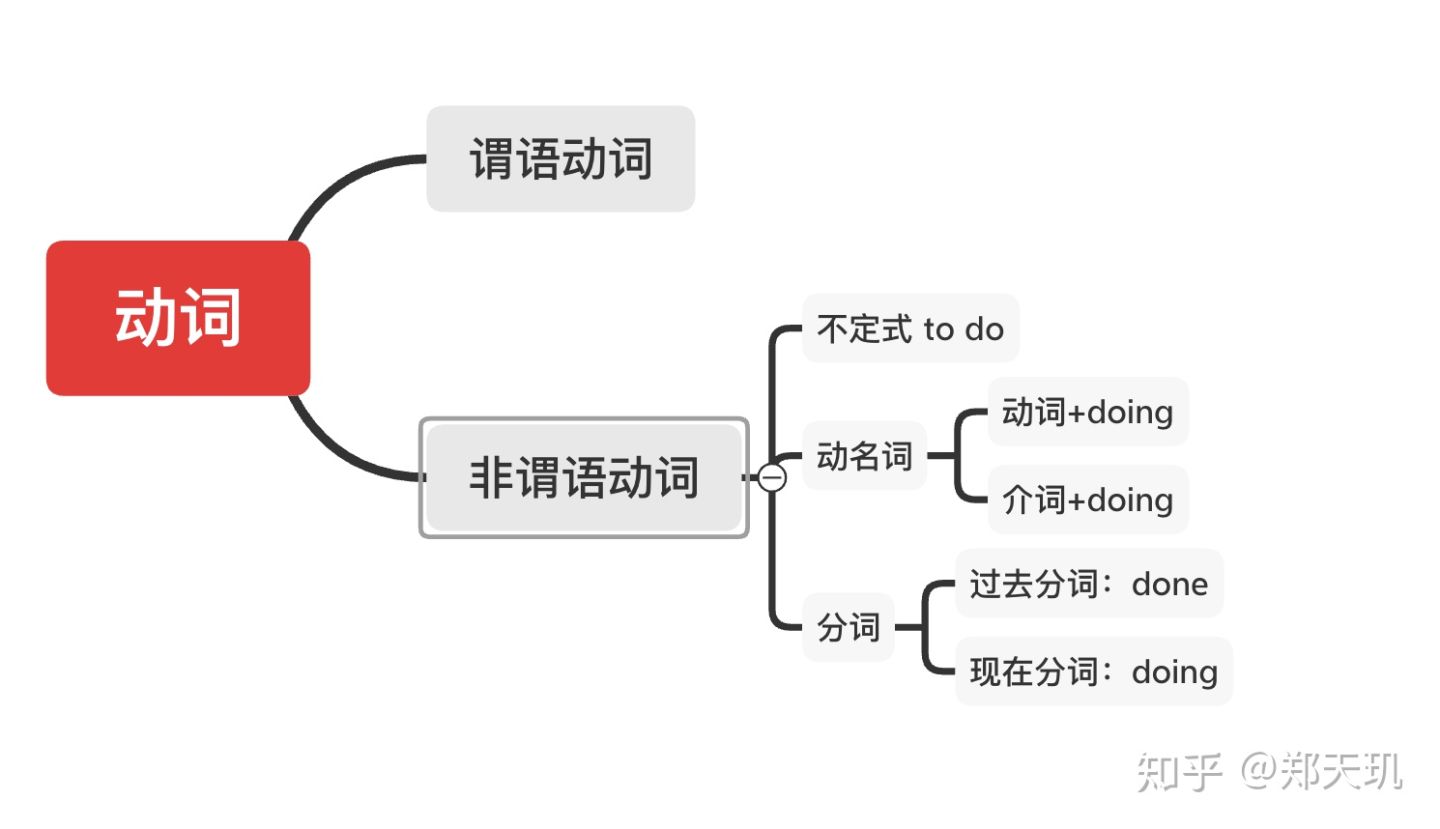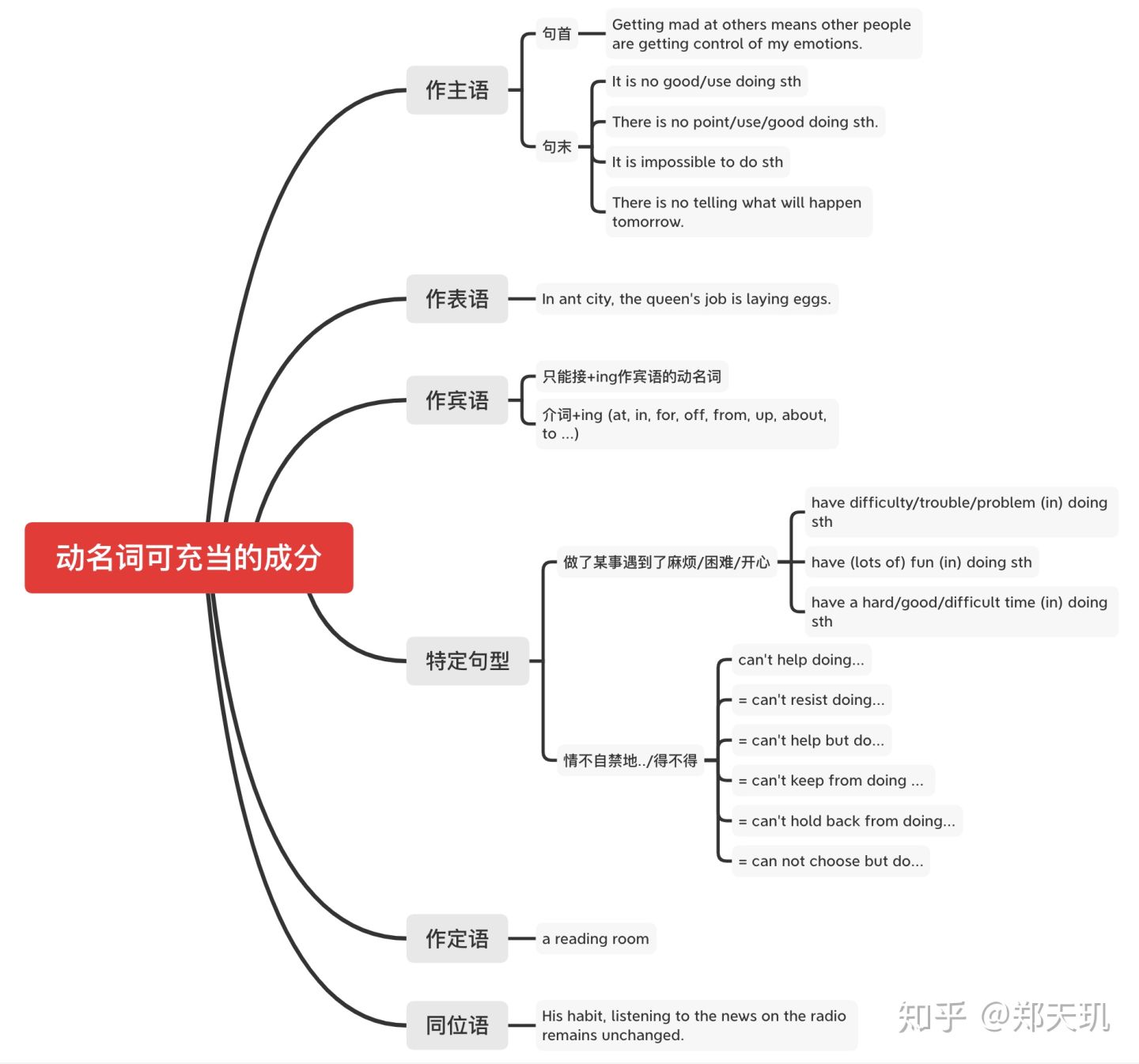非谓语动词
郑天玑
1 原则
谓语必然是动词,动词不一定是谓语
1.1 结构
动词分类

非谓语动词的存在条件:一个句子中存在一个主句,又没有连词的情况下,还有别的动词出现
例: She got off the bus, leaving her handbag on her seat. ( got off是谓语动词,She got off the bus是完整的句子,但整个句子中仍然存在leaving这个动词存在,这种情况下leaving就是非谓语动词,在整个句子中充当状语)
1.2 非谓语动词的使用场景

非谓语动词不能独立作谓语外,可以充当句子的任何成分,其中动名词不能作状语和独立成分,分词形式不可作宾语和主语。
例,加粗部分为非谓语动词:
1 The HR manager hurried to the airport only to be told the plane had taken off. (to be told 作结果状语)
2 He came running. (running 方式状语)
3 Taken as whole, the 16th Asian Games are well organized. (Taken 条件状语)
4 I told him not to make a mess in the kitchen. ( not to make,非谓语动词的否定形式一般加not或者never)
5 Not having received a letter, she decided to write to him again. (Not having received)
非谓语动词前,有逻辑主语时,not/never放在逻辑主语与非谓语动词之间。
6 I’m supprised at your not having noticed. (your是逻辑主语,not否定词,having noticed非谓语动词)
7 Jenny’s not having been trained as a dancer is her one regret. (Jenny’s逻辑主语,,not否定词,having been trained非谓语动词,整个句子的主语是Jenny’s not having been trained as a dancer)
1.3 非谓语动词的时态和语态

例,加粗部分为非谓语动词:
1 I have a lot of letters to be typed and you have to work overtime.
2 Having lived abroad for two decades, he speaks good English.
2 不定式
2.1 不定式作主语
例:
1 To finish the work in ten minutes is ver hard. (To finish the work in ten minutes是整个句子的主语)
It句型,不定式作主语置于句尾
2 It is very hard to finish the work in ten minutes.
3 It takes time and effort to master English.
4 It is my duty to help you with your English.
2.2 不定式作表语
例:
总体而言句子是一个svo的结构,由不定式充当表语
1 He was to perish in a shipwreck and to leave a wife and two children. (表示后果)
2 The next step is to make sure that you know exactly what is required. (表示目的)
3 You are to be rewarded. (用于被动语态,有情态意义)
4 These books are not to be sold. (那些书不应被卖掉)
5 Something is still to find out. ( 有些东西有待查明 )
6 A great deal is yet to do. (还有许多事情要做)
2.3 不定式作宾语
例:
1 I make up my mind to study management in college. (我下决心要在大学里学习管理学)
2 We can not believe him because he used to draw the long bow. ( draw the long bow夸夸其谈)
不定式作宾语的常见形式:
1 verb + to do:The company refused to cooperate with us.
2 verb + 疑问句 + to do: This book teaches you how to acquire new habits that can help improve your relation auto magically.
3 verb + it + 宾补 + to do: Using many symbols makes it possible to put a large ammount of imformation on a single map. (makes: verb, it 形式宾语+宾语提前,possible宾补,真正的宾语: to put a large ammount of imformation on a single map)
2.4 不定式作宾补
不定式的7个感观动词:see, hear, feel, watch, find, notice, listen to,3个使役动词:let, make, have,作宾补时:
主动语态:to要省略,被动语态:to要加上
例:
1 I saw him cross the road (cross前,to 省略)
2 He was seen to cross the road (被动语态,to加上)
2.5 不定式作定语
名词 + to do,不定式与其修饰的名词可以有各种逻辑语义关系:
动宾关系: I have a letter to write. (to write a letter 动词 宾语)
主语关系: The man to help you is Mr Johnson. (the man helps you)
同位语关系: The need to love and to be loved seems universal.
作状语:
表目的: He worked day and night to get the money. To have money, he was tried every means. (放在句首,主语同上一句一致) 表结果:往往指与愿望相反时用only/never He arrived late onlyto find the train had gone. 表原因:放形容词后面 They were very sad to hear the news.
2.6不定式作独立成分,修饰整个句子
例:
To begin with, on behalf of all of your American guests, I wish to thank you for the incomparable hospitally. (on behalf of 代表…)
2.7 省去to的不定式
2.7.1 使役动词、感观动词的主动语态省略to 例:
1 The mother makes her son play( [to] play ) the violin three hours a day
2 They love to watch(感观动词) people with different views get into ( [to] get into ) heated debates.
2.7.2 特殊句型省略to 句型1: had better, would rather, would sooner, might as well, can not but….
例:I can not but admire( [to] admire ) him courage
句型2: more than, rather than, other than, than
例: Rather than wait( [to] wait ) anymore, I decided to go home by taxi.
句型2: why (not) + do
例: Why not take( [to] take ) a holiday?
句型4:固定搭配 make do(设法应付) make believe(假装) let + do (使…)
例: Let’s make believe we are now on a deserted island.
句型5:不定式1 + and/or + 不定式2, 不定式2的to可以省略
例: He wish to study medicine and become ( [to] become ) a doctor.
3 动名词
一般式: doing, being done
完成式: having done, having been done
例:
1 Seeing is believing.
2 He came to party without being invited.
3 We remembered having seen the film.
4 he forgot having been taken to Guangzhou.
5 I regret not following his advice.
6 He suggest our( 物主代词 ) trying it once again.

there be 句型与动名词
There being: No one would have dreamed of there being such a good place. (多在于介词后面)
there to be: I don’t want there to be any misunderstanding on this point.( want to = want there to be)
4 现在分词
4.1 形式
doing 一般形式 / being done 被动
not + 现在分词(否定形式)
having done (完成时) / having been done(被动)
4.2 情景
4.2.1 doing 与 谓语动词同时发生:
例: They went to the park, singing and talking. (went是谓语动词,sing 和 talk是同时发生,边唱边聊去公园)
4.2.2 Have done, 谓语动词前发生
例:Having done the homework, he played basketball. 做完作业,他去打篮球了
4.2.3 having been done
例:Having been told many times, the naughty boy made the same mistake.
4.2.4 现在分词可作:定语,状语,补语,表语,以及独立成分
作定语时,可以视为定语的一个语法结构:
例:
in the following years => in the years that followed
the man speaking to the teacher => the man who is speaking to the teacher
动词均有动作的发出者:
谓语动词 –发出者–> 主语
非谓语动词 –发出着–> 逻辑主语
=> 现在分词作定语时,逻辑主语就是所修饰的名词或者代词
例:
He found a tree lying across the road. (tree是现在分词lying修饰的名词)
I could feel the sweat trickling down my back. (sweat是现在分词trickling down修饰的名词)
作表语时,用be + doing
例:The film being shown in the cinema is exciting.
注意:与动词一般进行时区分 He is playing football (不是系表结构)
作宾语
例:The police man observed the man entering the bank. ( entering the bank宾补 )
作状语
逻辑主语与句子主语一致
例:
Putting down my newspaper, I walked over to the window. (伴随状语)
He stayed at home, cleaning and washing. (方式状语)
He dropped the glass, breaking it into pieces. (结果状语)
Though raining heavily, it cleared up very soon. (让步状语)
I waiting for the bus, a bird fellen my head. (与逻辑主语构成独立主格)
All the tickets having been sold out, they want away disappointly. (与逻辑主语构成独立主格)
作独立成分:
例:
Juding from his appearance, he must be an actor. (从外表来看,他肯定是个演员)
Generally speaking, girls are more careful. (总体而言,女孩更加细心一点)
5 过去分词
过去分词可作:定语,状语,补语,表语,以及独立成分
作定语:
例: This will be the best novel of its kind ever written.( 修饰kind,可以替换为定语从句 that has ever been written )
作表语:
例: You seen frightened. (主系表结构)
少数不及物动词:go, come, set等的过去分词也可以做表语,但不表示被动意义
例: They are gone for vacation. 他们度假去了 不是被动语句
系表结构与被动语态:
a: The library is now closed. 系表结构,强调主谓关系,系动词前加类似 now rather very 等修饰
b: The library is closed at six. 被动语态,强调动宾关系,可以加 by 来制定执行者。
作宾语:
例: I hear the song sung several times last weak. (song是谓语动词,过去分词短语作宾语)
作状语:
例: Once seen, it can never be forgotten. (时间状语)
作独立成分:
例: Filled with hopes and fears, I entered the cave.
6 混淆点,动名词与现在分词的区别点
本质上,动名词是名词,现在分词是形容词,可以放形容词的地方就可以放现在分词,动名词同理。

区别1:
动名词:v + ing 与所修饰的名词之间没有逻辑上的主谓关系 => a swimming pool, a walking stick(一根手杖)
现在分词: v + ing 存在主谓关系 => 所有非谓语成分的现在分词作定语,都可以改为定语从句
现在分词短语作后置定语 The boy sitting on the sofa is my classmate. => 可以修改为who is sitting on the sofa 单个现在分词是前置定语 a speaking boy => a boy who is speaking 区别2:
动名词:名词所有格或物主代词 + v + ing,名词所有格或物主代词为v + ing的逻辑主语
例: Do you mind Jack’s playing with your son here?
现在分词:名称或人称代词宾格 + v + ing
例: I can hear students reading English on the campus.
区别3:
作表语时:动名词,名词作用;现在分词,形容词作用
动名词: 主 + 系 + v + ing,主语,表语的位置互换意思不变
例:Her job is looking after the children. => Looking after the children is her job.
现在分词:主语表示某人,某物或各种情况而表语又补充说明主语的特征,其前面可以加 very quite 等修饰词
例:
what he said is very inspiring.
The music is very exciting.
系动词为:look, sound, get, feel, keep, seem, become, remain等
例:The story sounds moving.